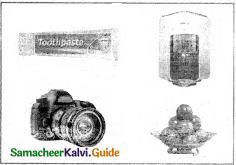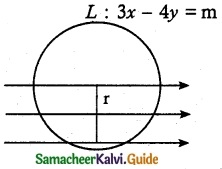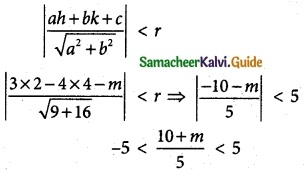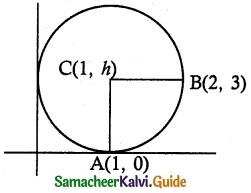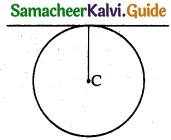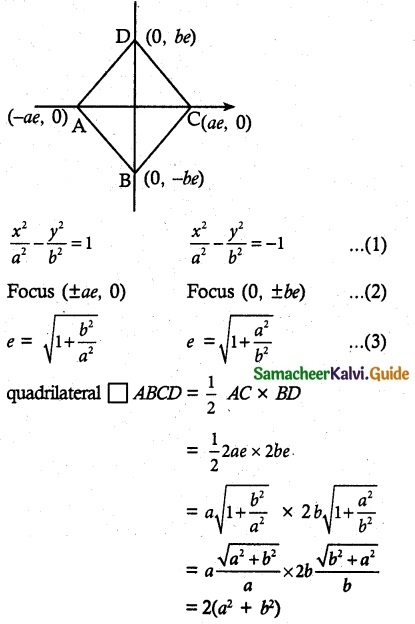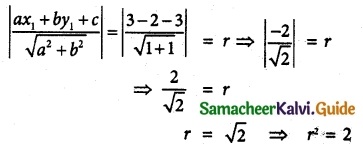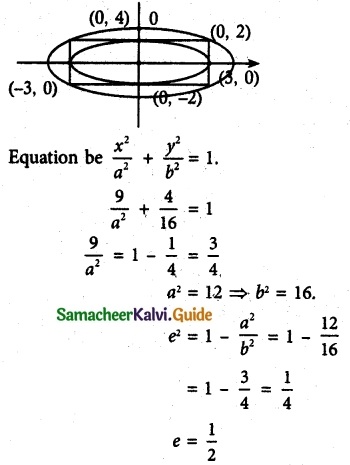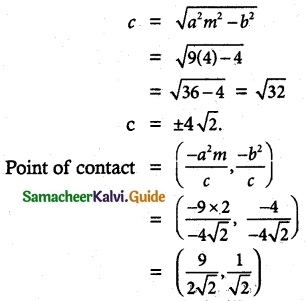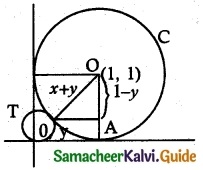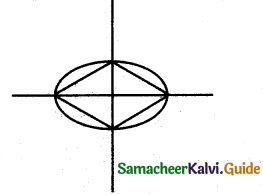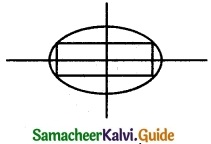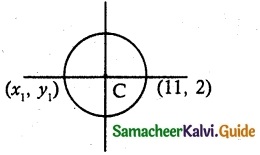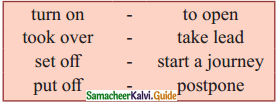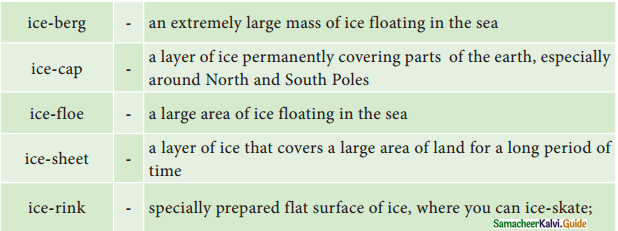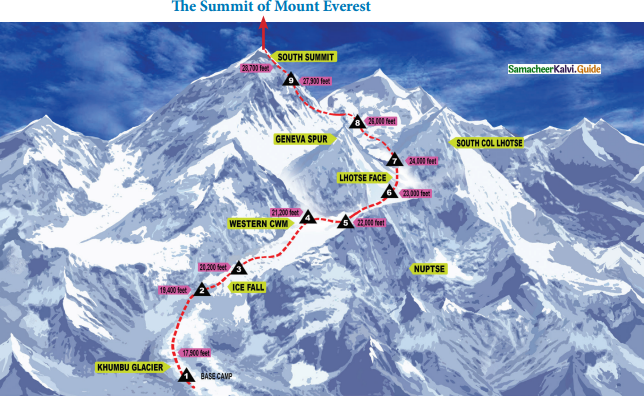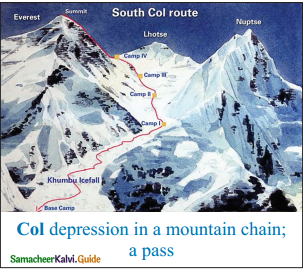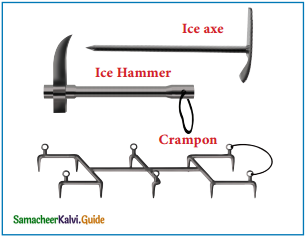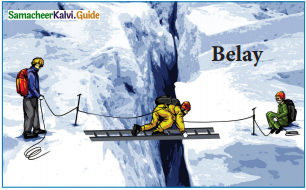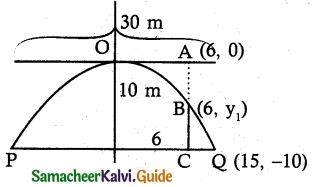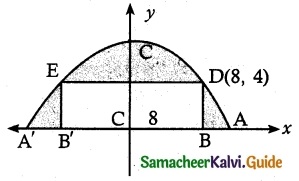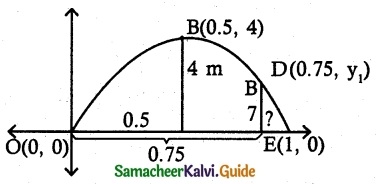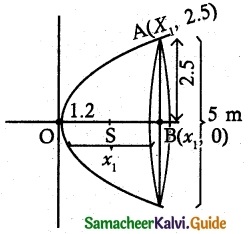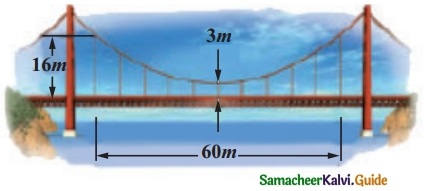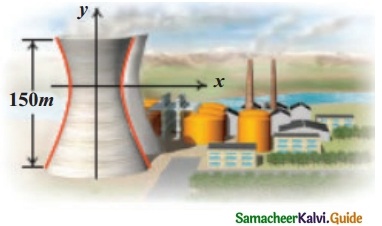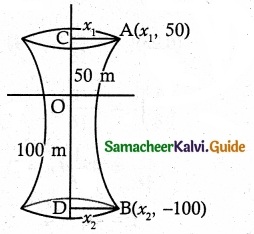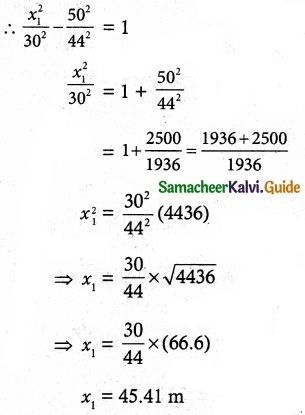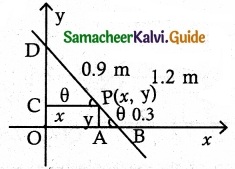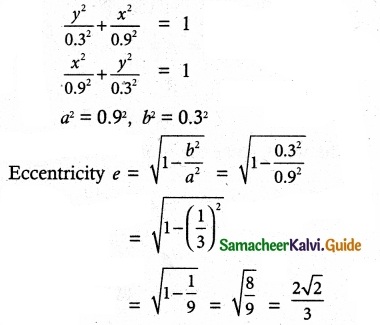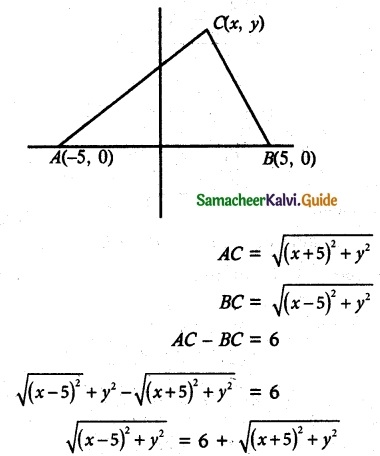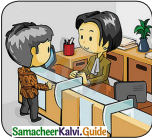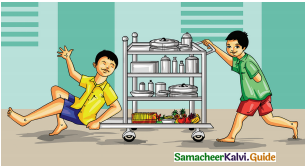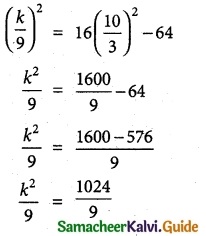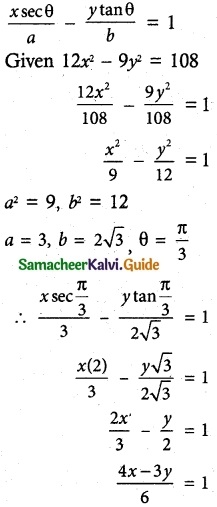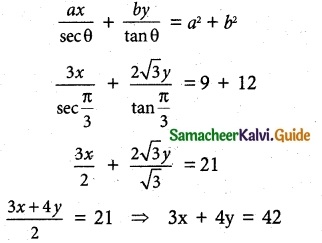Tamilnadu State Board New Syllabus Samacheer Kalvi 12th Maths Guide Pdf Chapter 6 Applications of Vector Algebra Ex 6.1 Textbook Questions and Answers, Notes.
Tamilnadu Samacheer Kalvi 12th Maths Solutions Chapter 6 Applications of Vector Algebra Ex 6.1
Question 1.
Prove by vector method that if a line is drawn from the centre of a circle to the midpoint of a chord; then the line is perpendicular to the chord.
Solution:
A circle with centre at O. AB is chord of the circle and OP bisects AB (ie) AP = PB
To prove \(\overline { OP }\) ⊥ \(\overline { AB }\) O is the position vector
∴ \(\overline { OA }\) = \(\overline { OB }\) = Radius
Position vector of P
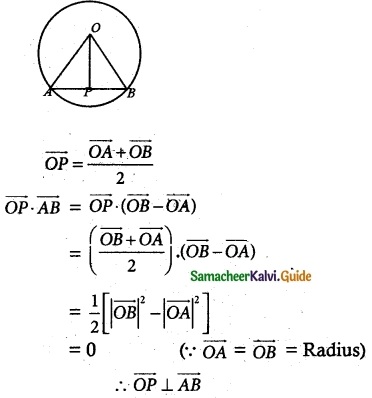
Hence proved
![]()
Question 2.
Prove by vector method that the median to the base of an isosceles triangle is perpendicular to the base.
Solution:
In isosceles ΔABC
Let AB = AC and AD is the median
D is the mid point of BC
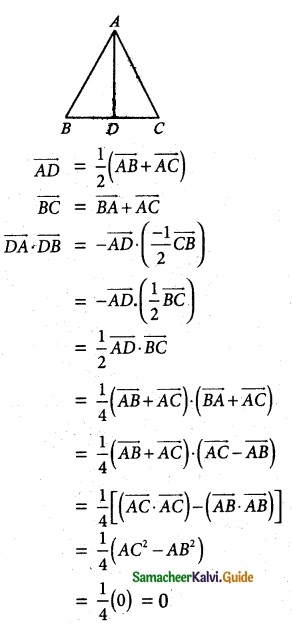
\(\overline { DA }\).\(\overline { DB }\) = 0
\(\overline { DA }\) ⊥ \(\overline { DB }\)
Question 3.
Prove by vector method that an angle in a semi-circle is a right angle.
Solution:

Let us consider a circle with centre O and diameter AB.
Let P be any point on the semi-circle.
Let us prove that ∠APB = 90°
W.K.T OA = OB = OP (∵ radius)
\(\overline { PA }\) = \(\overline { PO }\) + \(\overline { OA }\)
\(\overline { PB }\) = \(\overline { PO }\) + \(\overline { OB }\)
= \(\overline { PO }\) – \(\overline { OA }\)
\(\overline { PA }\). \(\overline { PB }\) = (\(\overline { PO }\) + \(\overline { OA }\))(\(\overline { PO }\) – \(\overline { OA }\))
= \(\overline { PO }\)² – \(\overline { OA }\)² = 0
\(\overline { PA }\) ⊥ \(\overline { PB }\)
⇒ ∠APB = 90°. Hence proved.
![]()
Question 4.
Prove by vector method that the diagonals of a rhombus bisect each other at right angles.
Solution:
ABCD is a rhombus
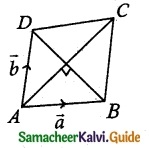
\(\overline { AB }\) = \(\overline { a }\) and \(\overline { AD }\) = \(\overline { b }\)
Here AB = BC = CD = DA
(ie) |\(\overline { a }\)| = |\(\overline { b }\)|
\(\overline { AC }\) = \(\overline { AB }\) + \(\overline { BC }\)
= \(\overline { a }\) + \(\overline { b }\)
\(\overline { BD }\) = \(\overline { BC }\) + \(\overline { CD }\)
= \(\overline { AD }\) – \(\overline { AB }\)
= \(\overline { b }\) – \(\overline { a }\)
\(\overline { AC }\).\(\overline { BD }\) = (\(\overline { a }\) + \(\overline { b }\)).(\(\overline { b }\) – \(\overline { a }\))
= (\(\overline { b }\) + \(\overline { a }\)).(\(\overline { b }\) – \(\overline { a }\))
= (\(\overline { b }\))² – (\(\overline { a }\))² = 0 (∵ |\(\overline { a }\)| = |\(\overline { b }\)|)
\(\overline { AC }\).\(\overline { BD }\) = 0 ⇒ \(\overline { AC }\) ⊥ \(\overline { BD }\)
Hence proved.
Question 5.
Using vector method, prove that if the diagonals of a parallelogram are equal, then it is a rectangle.
Solution:
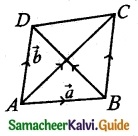
ABCD is a parallelogram with sides
\(\overline { AB }\) = \(\overline { a }\), \(\overline { AD }\) = \(\overline { b }\) and the diagonals are \(\overline { AC }\) and \(\overline { BD }\)
\(\overline { AC }\) = \(\overline { AB }\) + \(\overline { BC }\) = \(\overline { AB }\) + \(\overline { AD }\) = \(\overline { a }\) + \(\overline { b }\)
\(\overline { BD }\) = \(\overline { BA }\) + \(\overline { AD }\) = \(\overline { AD }\) – \(\overline { AB }\) = \(\overline { b }\) – \(\overline { a }\)
Since the diagonals are equal
|\(\overline { AC }\)| = |\(\overline { BD }\)|
|\(\overline { a }\) + \(\overline { b }\)| = |\(\overline { b }\) – \(\overline { a }\)|
(\(\overline { a }\) + \(\overline { b }\))² = (\(\overline { b }\) – \(\overline { a }\))²
\(\overline { a }\)² + 2\(\overline { a }\).\(\overline { b }\) + \(\overline { b }\)² = \(\overline { b }\)² – 2\(\overline { b }\) \(\overline { a }\) + \(\overline { a }\)²
4\(\overline { a }\) \(\overline { b }\) = 0
\(\overline { a }\).\(\overline { b }\) = 0
\(\overline { a }\) ⊥\(\overline { b }\) ⇒ ABCD is a rectangle. Since ∠A = 90°.
![]()
Question 6.
Prove by vector method that the area of the quadrilateral ABCD having diagonals AC and BD is \(\frac { 1 }{ 2 }\) |\(\overline { AC }\)| = |\(\overline { BD }\)|
Solution:
Vector area of a quadrilateral ABCD
= Vector area of ΔABC + Vector area of ΔACD
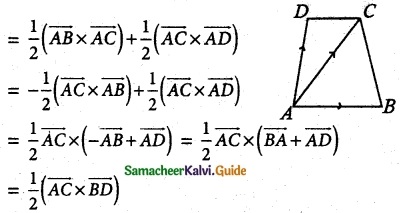
Area of quadrilateral
= \(\frac { 1 }{ 2 }\) |\(\overline { AC }\)| = |\(\overline { BD }\)|
Question 7.
Prove by vector method that the parallelograms on the same base and between the same parallels are equal in area.
Solution:
\(\overline { AB }\) = \(\overline { a }\), \(\overline { AD }\) = \(\overline { b }\)
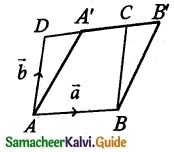
Vector area of the parallelogram is \(\overline { b }\) × \(\overline { a }\) ……(1)
Consider the parallelogram ABB’A’
\(\overline { AB }\) = \(\overline { a }\), \(\overline { AB }\) = m\(\overline { a }\)
Because \(\overline { A’B }\) is parallel to \(\overline { AB }\)
Consider the triangle ADA’
By law of vectors AA’ = m\(\overline { a }\) + \(\overline { b }\)
Hence the vector area of parallelogram
ABB’A = \(\overline { a }\) × (m\(\overline { a }\) + \(\overline { b }\))
= m(\(\overline { a }\) × \(\overline { a }\)) + (\(\overline { a }\) × \(\overline { b }\))
= 0 + (\(\overline { a }\) × \(\overline { b }\))
= \(\overline { a }\) × \(\overline { b }\) ……..(2)
By (1) and (2) Area of ABCD = Area of ABB’A’
Hence proved.
![]()
Question 8.
If G is the centroid of a ΔABC, prove that (area of ΔGAB) = (area of ΔGBC) = (area of ΔGCA) = \(\frac { 1 }{ 3 }\) (area of ΔABC).
Solution:
W.K.T the median of a triangle divides it into two triangles of equal area.
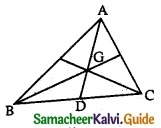
In ΔABC, AD is the median
area (ΔABD) = area (ΔACD) ………. (1)
In ΔGBC, GD is die median
area (ΔGBD) = area (ΔGCD) ………. (2)
Sub (2) from (1) we get
area (ΔABD) – area (ΔGBD)
= area (ΔACD) – area (ΔGCD)
area(ΔAGB) = area(ΔAGC) ………… (3)
Similarly
area (ΔAGB) = area (ΔBGC) …………(4)
From (3) and (4) we get
area (ΔAGB) = area(ΔAGC) = area(ΔBGC) ……….. (5)
Now
area(ΔAGB) + area(ΔAGC) + area(ΔBGC) = area(ΔABC)
⇒ area(ΔAGB) + area(ΔAGB) + area(ΔAGB)
= area (ΔABC) (using 5)
⇒ 3area(ΔAGB) = area(ΔABC)
⇒ axea(ΔAGB) = \(\frac { 1 }{ 3 }\) area(ΔABC) ………..(6)
From (5) and (6) we get
area(ΔAGB) = area(ΔAGB) = area(ΔBGC)
= \(\frac { 1 }{ 3 }\) area(ΔABC)
Question 9.
Using vector method, prove that
cos(α – ß) = cos α cos ß + sin α sin ß.
Solution:
Let \(\overline { a }\) = \(\overline { OA }\), \(\overline { b }\) = \(\overline { OB }\) be the unit vectors and which make angles α and ß respectively with positive x-axis where A and B are as in diagram.
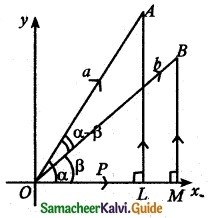
Draw AL and BM perpendicular to the X axis, then
\(\overline { OL }\) = \(\overline { OA }\) = cos α
|\(\overline { OL }\)| = |\(\overline { OA }\)| cos α = cos α
|\(\overline { LA }\)| = |\(\overline { OA }\)| sin α = sin α
\(\overline { OL }\) = |\(\overline { OL }\)|\(\hat { i }\) = cos α \(\hat { i }\)
\(\overline { LA }\) = sin α (+\(\hat { j }\))
\(\overline { a }\) = \(\overline { OA }\) = \(\overline { OL }\) + \(\overline { LA }\)
= cosα \(\hat { i }\) + sinα \(\hat { j }\) ……… (1)
Similarly \(\overline { b }\) = cos ß \(\hat { i }\) + sin ß \(\hat { j }\) ……… (2)
The angle between \(\overline { a }\) and \(\overline { b }\) is α – ß and so \(\overline { a }\).\(\overline { b }\) = |\(\overline { a }\)||\(\overline { b }\)| cos(α – ß) = cos(α – ß) ……..(3)
From (1) and (2)
\(\overline { a }\).\(\overline { b }\) = (cosα\(\hat { i }\) + sinα \(\hat { j }\)).(cosß\(\hat { i }\) + sinß\(\hat { j }\))
= cos α cos ß + sin α sin ß ………. (4)
From (3) and (4)
cos(α – ß) = cos α cos ß + sin α sin ß
![]()
Question 10.
Prove by vector method that
sin(α + ß) = sin α cos ß +cos α sin ß.
Solution:
Let \(\overline { a }\) = \(\overline { OA }\), \(\overline { b }\) = \(\overline { OB }\) be the unit vectors making angles α and ß respectively with positive x axis where A and B are as shown in the diagram
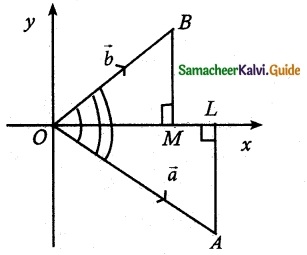
Draw AL and BM perpendicular to the X axis, then
\(\overline { OL }\) = \(\overline { OA }\) cos α
|\(\overline { OL }\)| = |\(\overline { OA }\)| cos α = cos α
|\(\overline { LA }\)| = |\(\overline { OA }\)| sin α = sin α
|\(\overline { OL }\)| = |\(\overline { OL }\)| \(\hat { i }\) = cos α \(\hat { i }\)
\(\overline { LA }\) = sin α(-\(\hat { j }\))
\(\overline { a }\) = \(\overline { OA }\) = \(\overline { OL }\) + \(\overline { LA }\)
= cos α \(\hat { i }\) + sin α \(\hat { j }\) ………… (1)
similarly \(\overline { b }\) = cos ß \(\hat { i }\) – sin ß \(\hat { j }\) ………… (2)
The angle between \(\overline { a }\) and \(\overline { b }\) is α + ß and the vectors \(\overline { b }\), \(\overline { a }\), \(\overline { k }\) from a right handed system.
\(\overline { b }\) × \(\overline { a }\) = |\(\overline { b }\)||\(\overline { a }\)| sin(α + ß)\(\hat { k }\) = sin(α + ß)\(\hat { k }\) ………..(1)
\(\overline { b }\) × \(\overline { a }\) = \(\left|\begin{array}{ccc}
\hat{i} & \hat{j} & \hat{k} \\
\cos \beta & -\sin \beta & 0 \\
\cos \alpha & \sin \alpha & 0
\end{array}\right|\)
= (sin α cos ß + cos α sin ß)\(\hat { k }\) ……… (2)
From (1) & (2)
sin(α + ß) = sin α cos ß + cos α sin ß
Question 11.
A particle acted on by constant forces 8\(\hat { i }\) + 2\(\hat { j }\) – 6\(\hat { k }\) and 6\(\hat { i }\) + 2\(\hat { j }\) – 2\(\hat { k }\) is displaced from the point (1, 2, 3) to the point (5, 4, 1). Find the total work done by the forces.
Solution:
\(\overline { OA }\) = \(\hat { i }\) + 2\(\hat { j }\) + 3\(\hat { k }\)
\(\overline { OB }\) = 5\(\hat { i }\) + 4\(\hat { j }\) + \(\hat { k }\)
\(\overline { d }\) = \(\overline { AB }\) = \(\overline { OB }\) – \(\overline { OA }\)
= 4\(\hat { i }\) + 2\(\hat { j }\) – 2\(\hat { k }\)
\(\overline { F_1 }\) = 8\(\hat { i }\) + 2\(\hat { j }\) – 6\(\hat { k }\)
and \(\overline { F_2 }\) = 6\(\hat { i }\) + 2\(\hat { j }\) – 2\(\hat { k }\)
\(\overline { F }\) = \(\overline { F_1 }\) + \(\overline { F_2 }\) = 14\(\hat { i }\) + 4\(\hat { j }\) – 8\(\hat { k }\)
Work done = \(\overline { F }\) \(\overline { d }\)
= (14\(\hat { i }\) + 4\(\hat { j }\) – 8\(\hat { k }\)).(4\(\hat { i }\) + 2\(\hat { j }\) – 2\(\hat { k }\))
= 56 + 8 + 16
= 80 units
![]()
Question 12.
Forces of magnitudes 5√2 and 10√2 units acting in the directions 3\(\hat { i }\) + 4\(\hat { j }\) + 5\(\hat { k }\) and 10\(\hat { i }\) + 6\(\hat { j }\) – 8\(\hat { k }\), respectively, act on a particle which is displaced from the point with position vector 4\(\hat { i }\) – 3\(\hat { j }\) – 2\(\hat { k }\) to the point with position vector 6\(\hat { i }\) – \(\hat { j }\) – 3\(\hat { k }\). Find the work done by the forces.
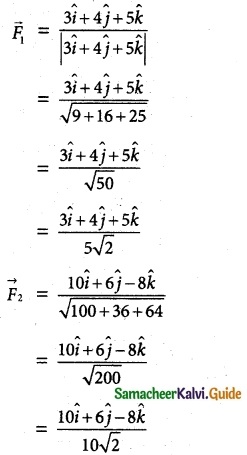
Resultant force \(\overline { F }\) = \(\overline { F_1 }\) + \(\overline { F_2 }\)
= 5√2\(\overline { F_1 }\) + 10√2 \(\overline { F_2 }\)
= 3\(\hat { i }\) + 4\(\hat { j }\) + 5\(\hat { k }\) + 10\(\hat { i }\) + 6\(\hat { j }\) – 8\(\hat { k }\)
= 13\(\hat { i }\) + 10\(\hat { j }\) – 3\(\hat { k }\)
\(\overline { OA }\) = 4\(\hat { i }\) – 3\(\hat { j }\) – 2\(\hat { k }\)
\(\overline { OB }\) = 6\(\hat { i }\) + \(\hat { j }\) – 3\(\hat { k }\)
\(\overline { d }\) = \(\overline { AB }\) = \(\overline { OB }\) – \(\overline { OA }\) = 2\(\hat { i }\) + 4\(\hat { j }\) – \(\hat { k }\)
\(\overline { F }\).\(\overline { d }\) = (13\(\hat { i }\) + 10\(\hat { j }\) – 3\(\hat { k }\)).(2\(\hat { i }\) + 4\(\hat { j }\) – \(\hat { k }\))
= 26 + 40 + 3
= 69 units
Question 13.
13. Find the magnitude and direction cosines of the torque of a force represented by 3\(\hat { i }\) + 4\(\hat { j }\) – 5\(\hat { k }\) about the point with position vector 2\(\hat { i }\) – 3\(\hat { j }\) + 4\(\hat { k }\) acting through a point whose position vector is 4\(\hat { i }\) + 2\(\hat { j }\) – 3\(\hat { k }\)
Solution:
\(\overline { OA }\) = 2\(\hat { i }\) – 3\(\hat { j }\) + 4\(\hat { k }\)
\(\overline { OB }\) = 4\(\hat { i }\) + 2\(\hat { j }\) – 3\(\hat { k }\)
\(\hat { r }\) = \(\overline { AB }\) = \(\overline { OB }\) – \(\overline { OA }\)
= 2\(\hat { i }\) + 5\(\hat { j }\) – 7\(\hat { k }\)
= 3\(\hat { i }\) + 4\(\hat { j }\) – 5\(\hat { k }\)
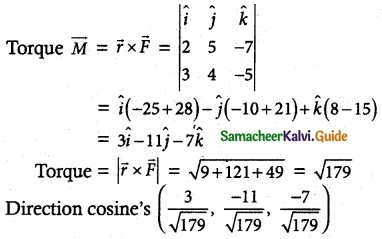
![]()
Question 14.
Find the torque of the resultant of the three forces represented by -3\(\hat { i }\) + 6\(\hat { j }\) – 3\(\hat { k }\), 4\(\hat { i }\) – 10\(\hat { j }\) + 12\(\hat { k }\) and 4\(\hat { i }\) + 7\(\hat { j }\) acting at the point with position vector 8\(\hat { i }\) – 6\(\hat { j }\) – 4\(\hat { k }\) about the point with position vector 18\(\hat { i }\) + 3\(\hat { j }\) – 9\(\hat { k }\)
Solution:
\(\overline { F_1 }\) = -3\(\hat { i }\) + 6\(\hat { j }\) – 3\(\hat { k }\)
\(\overline { F_2 }\) = 4\(\hat { i }\) – 10\(\hat { j }\) + 12\(\hat { k }\)
\(\overline { F_3 }\) = 4\(\hat { i }\) + 7\(\hat { j }\)
\(\overline { F }\) = \(\overline { F_1 }\) + \(\overline { F_2 }\) + \(\overline { F_3 }\)
= 5\(\hat { i }\) + 3\(\hat { j }\) + 9\(\hat { k }\)
\(\overline { OB }\) = 8\(\hat { i }\) – 6\(\hat { j }\) – 4\(\hat { k }\)
\(\overline { OA }\) = 18\(\hat { i }\) + 3\(\hat { j }\) – 9\(\hat { k }\)
\(\overline { AB }\) = \(\overline { OB }\) – \(\overline { OA }\)
= -10\(\hat { i }\) – 9\(\hat { j }\) + 5\(\hat { k }\)
\(\overline { t }\) = \(\overline { r }\) × \(\overline { F }\) = \(\left|\begin{array}{ccc}
\hat{i} & \hat{j} & \hat{k} \\
-10 & -9 & 5 \\
5 & 3 & 9
\end{array}\right|\)
= \(\hat { i }\)(-81 – 15) – \(\hat { j }\)(-90 – 25) + \(\hat { k }\)(-30 + 45)
= -96\(\hat { i }\) + 115\(\hat { j }\) + 15\(\hat { k }\)
![]()
